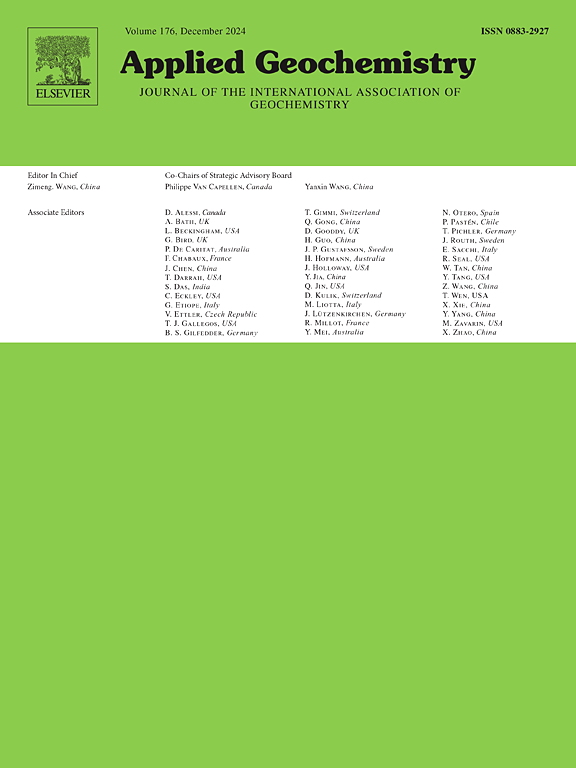Variability of fracture surface roughness in crystalline host rocks: implications for transport model simplifications
IF 3.4
3区 地球科学
Q1 GEOCHEMISTRY & GEOPHYSICS
引用次数: 0
Abstract
Variability in fracture geometry and its complex surface characteristics are major contributors to solute transport and retention effects in rocks such as granite. Understanding the effects of cross-scale fracture geometry on solute transport modeling is critical for reliable quantitative predictions in applications such as geothermal energy use and nuclear repository safety. Here, we systematically investigated the sensitivity of fracture surface topography variability to the flow field and solute transport behavior. Specifically, we investigated the role of multiscale fracture surface roughness in solute transport modeling. As a starting point, our study utilized a 3D fracture geometry derived from CT scans and employed COMSOL Multiphysics software for solute transport modeling. By introducing increasingly lower spatially resolved geometries, while maintaining a constant high resolution mesh for simulation calculations, we investigated the consequences for transport on surfaces composed of superimposed building blocks of different sizes and shapes. The results indicate that fracture geometry simplifications with reduced spatial frequency information of well-defined, specific domains do not have a clear trend to alter the BTCs tailing. Instead, this type of model simplification can cause both increased and decreased tracer residence times, leading to misleading interpretations. We explain this by a complex superposition of surface building blocks of different sizes, such as single crystal surface pits, grain boundaries between crystals, and fracture curvature. For model sensitivity analyses, we suggest the use of concentration difference and acceleration maps to identify local transport heterogeneities introduced by geometric simplifications. In addition, we conclude that power spectral density (PSD) analysis provides a means of defining a range of surface spatial frequencies that helps to avoid oversimplification in geometric models of reactive transport.
晶体寄主岩石裂缝表面粗糙度的可变性:对输运模型简化的影响
裂缝几何形状的变化及其复杂的表面特征是花岗岩等岩石中溶质运移和保留效应的主要因素。了解跨尺度裂缝几何形状对溶质运移建模的影响对于地热能利用和核储存库安全等应用的可靠定量预测至关重要。在这里,我们系统地研究了裂缝表面形貌变化对流场和溶质输运行为的敏感性。具体来说,我们研究了多尺度断裂表面粗糙度在溶质输运模型中的作用。作为研究的起点,我们利用CT扫描得出的三维裂缝几何形状,并使用COMSOL Multiphysics软件进行溶质运移建模。通过引入越来越低的空间分辨率几何图形,同时保持恒定的高分辨率网格进行模拟计算,我们研究了由不同大小和形状的叠加构建块组成的表面上的传输后果。结果表明,裂缝几何形状简化后,减少了定义明确的特定区域的空间频率信息,对btc尾砂没有明显的改变趋势。相反,这种类型的模型简化会导致示踪剂停留时间的增加和减少,从而导致误导性的解释。我们通过不同尺寸的表面构建块的复杂叠加来解释这一点,例如单晶表面凹坑,晶体之间的晶界和断裂曲率。对于模型敏感性分析,我们建议使用浓度差和加速度图来识别由几何简化引入的局部输运异质性。此外,我们得出结论,功率谱密度(PSD)分析提供了一种定义表面空间频率范围的方法,有助于避免反应输运几何模型的过度简化。
本文章由计算机程序翻译,如有差异,请以英文原文为准。
求助全文
约1分钟内获得全文
求助全文
来源期刊

Applied Geochemistry
地学-地球化学与地球物理
CiteScore
6.10
自引率
8.80%
发文量
272
审稿时长
65 days
期刊介绍:
Applied Geochemistry is an international journal devoted to publication of original research papers, rapid research communications and selected review papers in geochemistry and urban geochemistry which have some practical application to an aspect of human endeavour, such as the preservation of the environment, health, waste disposal and the search for resources. Papers on applications of inorganic, organic and isotope geochemistry and geochemical processes are therefore welcome provided they meet the main criterion. Spatial and temporal monitoring case studies are only of interest to our international readership if they present new ideas of broad application.
Topics covered include: (1) Environmental geochemistry (including natural and anthropogenic aspects, and protection and remediation strategies); (2) Hydrogeochemistry (surface and groundwater); (3) Medical (urban) geochemistry; (4) The search for energy resources (in particular unconventional oil and gas or emerging metal resources); (5) Energy exploitation (in particular geothermal energy and CCS); (6) Upgrading of energy and mineral resources where there is a direct geochemical application; and (7) Waste disposal, including nuclear waste disposal.
 求助内容:
求助内容: 应助结果提醒方式:
应助结果提醒方式:


